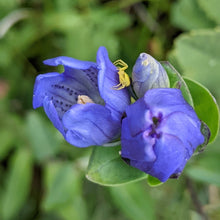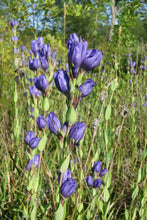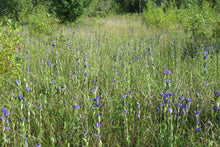
Gentiana sceptrum
King’s Gentian, also known as staff gentian, is equal parts breathtaking and rare in the garden setting. It emerges in spring as several stems covered in oval-shaped foliage, eventually growing one to three feet tall and flaunting extremely showy flowers. The plump, tubular blooms arrive in mid to late summer in intense shades of purplish-blue with dark green specks or streaks inside. By fall, blooms fade into small capsule-shaped fruit containing tiny winged seeds.
- Plant type/canopy layer: deciduous, perennial, herbaceous plant
- Size at maturity: 8-30” tall, equally wide
- Light requirements: full sun
- Moisture requirements: moist to seasonally wet soil
- Bloom time: May - September (June - September in the Portland Metro area)
- Growth rate/ease: moderate growth rate, can be difficult to grow because it requires a site with ample moisture
- Wildlife support: gentiana species are believed to be used by just a few highly specialized pollinators
- Native habitat/range: relatively uncommon, especially in the nursery industry, grows in bogs, wet meadows, and along lake margins at low elevations from British Columbia to northern California, from the western Cascades to the coast. Portland Plant List - yes.
- Special features & uses: there are records citing the use of species from this genus from all over the world, particularly in the Middle East and China, dating back more than 2000 years. Though we did not find any specific references for our local Gentiana sceptrum, many sources cite that the root of other gentian species can be used to clear toxicity from animal venom, such as scorpions and snakes, and for alcohol overconsumption, as well as to treat infected wounds, inflammation and swelling (particularly of the liver), and digestive issues. Of course, always do extensive research and/or consult an expert before using wild plant medicine.
Gardening with King's Gentian: Given how uncommon this plant is in nature, and in the nursery industry, it works surprisingly well in gardens, provided it is planted in a sunny location where it will receive ample moisture, such as a sunny raingarden. It will likely require supplemental water in the summer months. Personally, I like taking advantage of low-lying areas close to annual vegetable plants, where it's easy to hit with extra water while hand watering the vegetables and any excess water naturally flows.
Photo Credit 1: Photo 310263453, (c) Jan Smith, some rights reserved (CC BY), uploaded by Jan Smith
Photo Credits 2-4: King's Scepter Gentian Gentiana sceptrum, Observation © Ed Alverson, CC BY 4.0 DEED







